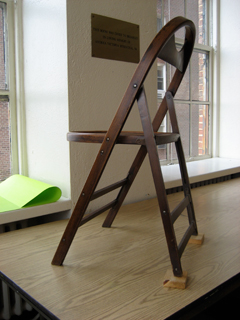
Q: I have chronic back trouble and haven’t yet found a position for meditation that I can bear for more than ten minutes. I’ve tried just about everything, from seizas to zafus to zabutons to gomdens, in various shapes and degrees of firmness – nothing seems to work for me. I know some teachers write that pain is part of the process, but I just can’t seem to get past the physical agony.
It’s true that the priority of cushion sitting is apparent almost wherever you look. (Just look at the name of this column.) The Buddha himself spoke of “the case where a monk, having gone to the wilderness, to the shade of a tree, or to an empty building, sits down folding his legs crosswise, holding his body erect, and setting mindfulness to the fore” (Anapanasati Sutta, MN 118). The thirteenth-century master Eihei Dogen, in his “Rules for Zazen,” notes: “There are examples from the past of sitting on a diamond seat and sitting on a flat stone covered with a thick layer of grass,” but he goes on to instruct: “When sitting zazen, wear the kashaya and use a round cushion.”
All honor to Dogen, and all respect as well to those teachers who tell us that pain is a normal stage in learning to sit or a valuable challenge to meet. In Tricycle’s Summer 2007 issue, meditation teacher Bodhipaksa – whose website, wildmind.org, includes an encouraging page for chair sitters – instructs: “As you use the breath to soften resistance to the pain or discomfort, you may notice how the experience of pain is in fact a constantly changing mass of different sensations. Experience how it comes into being and passes away moment by moment.”

Yet those who have long-term or chronic back pain may need more in the way of material support to really get started, or to escape an off-and-on practice with its accompanying feelings of guilt and discouragement. If pain regularly makes you cut meditation short or makes you dread sitting altogether, it’s time to try something new. (Maezumi Roshi: “When you sit, please remind yourself how you can sit best. When you do that, all the buddhas and ancestors guarantee it is the right way.”)
The system offered here uses a chair rather than a cushion and is set up in three stages – the first two are essential; the third is optional but highly recommended.
1. Use a straight chair, not one where the seat angles back (as many do). If you can, get a couple of wooden blocks, about an inch thick. These are easy to carry around. Place them under the back legs of the chair so that you are very slightly angled forward. If you don’t have blocks, two small paperback books will do.
2. To ensure that you don’t lean against the back of the chair, and to support the base of the spine, use something firm but pliable to act as a wedge-support. It can be a small rolled-up towel, or a small pillow, or even a hard plastic binder, used to lift the very back of the buttocks at the base of the spine (not the flesh of the upper legs). You will know that the angle of the body is right when you are upright and at rest.
3. If you feel your back is not strong enough to hold an upright position, or are actively experiencing pain, a truly wonderful tool is the Nada Chair (nadachair.com), a portable, cushioned, and attractive lumbar support that is held around the waist with a Velcro band, while two cushioned adjustable straps use the knees as a fulcrum to allow the body to relax in an upright position you never thought you could attain. They can also be used while cross-legged. If you are small-boned, their “S’port Backer” will work for you; otherwise, get the “Back-Up,” which astronauts have used to reduce back pain. I received one years ago from my sister and have recommended them unreservedly ever since then.
Perhaps the most difficult part of this approach is letting go of one’s attachment to the idea of sitting like everyone else, especially during group practice (on a retreat, for example), where it seems to be assumed that everyone will bring their cushions and sink onto the mat at the right moment. We don’t like to stick out, and the self-criticism that can follow is one of the heaviest impediments there is to attaining any real inner alignment. As a first step, why not try any or all of these steps at home for a week or two, to see whether they make a difference for you as you explore how you yourself—with the body just as it is—can approach sitting meditation positively and with increasing confirmation of its profound value.▼
Thank you for subscribing to Tricycle! As a nonprofit, we depend on readers like you to keep Buddhist teachings and practices widely available.